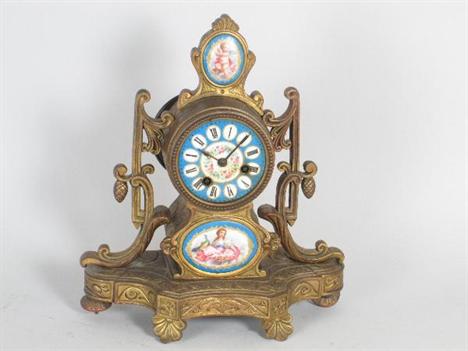An Edwardian brass dialled wall clock, the double fusee, eight-day duration movement striking the hours on a gong, with the eight-inch square brass dial engraved with black Roman numerals, floral & rococo dial centre and matching spandrels, with blued steel spade hands, contained in a walnut case with the barley-twist columns having cast brass capitals and havingf wooden frets to the side doors, height: 50cm.
460333 Preisdatenbank Los(e) gefunden, die Ihrer Suche entsprechen
460333 Lose gefunden, die zu Ihrer Suche passen. Abonnieren Sie die Preisdatenbank, um sofortigen Zugriff auf alle Dienstleistungen der Preisdatenbank zu haben.
Preisdatenbank abonnieren- Liste
- Galerie
-
460333 Los(e)/Seite
William Gill, Maidstone A mid 18th century lacquer longcase clock, the five pillar, eight-day duration movement striking the hours on a bell with internal rack striking, the twelve-inch arched brass dial engraved with wheatear border decoration, with the raised, silvered chapter ring engraved with black Roman numerals, Arabic outer five-minute numerals and ‘fleur-de-lys’ half-hour markings, the matted dial centre having engraved floral and bird decoration, ringed winding holes and having a subsidiary seconds dial and date aperture, with ‘female-head’ cast brass corner spandrels and blued steel hands, the silvered boss to the arch engraved with the maker’s name ‘Wm Gill, Maidstone’, the case of ‘tortoiseshell’ lacquer decorated with raised gilt chinoiserie work, with an arched trunk door, the arched hood with three-quartered columns to the front and two giltwood ball and spire finials, height: 200cm. * William Gill is recorded as working in Maidstone, Kent in the early 18th century having been apprenticed in 1704 and given his freedom in 1710. He is one of Maidstone’s most celebrated & competent clockmakers’ with a number of fine longcase clocks known by him. He supplied the clocks for a number of public buildings including both Rainham and St Nicholas of Leeds churches.
A mahogany moonphase longcase clock, the eight day duration movement striking the hours on a bell with the fourteen-inch painted arched dial having black Roman numerals, gilt floral corner spandrels and moon phase disc to arch, with decorative brass hands and subsidiary seconds dial and date aperture, the falseplate to the dial embossed with the dial makers’ name ‘Finnemore & Sons’ of Birmingham, the case profusely inlaid in various woods and having a short door, canted corners to the trunk, fluted hood pillars with brass capitals and a swan neck pediment, height: 250cm. * Finnemore & Son were well known Birmingham dialmakers’ with William Finnemore originally being part of the Walker & Finnemore partnership, continuing on his own account from 1812 and becoming ‘& Son’ from 1828 until 1836.
Wesley, Denham An oak longcase clock, the eight day duration movement striking on a bell with the twelve-inch painted arched dial having black Arabic numerals, floral corner spandrels, the decoration to the arch depicting swans on a lake, with brass hands, a subsidiary seconds dial and signed ‘Wesley Denham’, the false plate stamped with the dialmakers’ name ‘Francis, Birmingham’, the case having a curved trunk door, plain base, with the hood having fluted columns with brass capitals and three ball-and-spire finials to the moulded pediment, height: 225cm. * The dialmaker William Francis is recorded as working firstly in Thorp Street, then Old Inkleys and finally 11 Smallbrook Street, Birmingham from 1810 until 1831 and was a prolific maker.
An Oak Longcase Clock, the eight day duration movement striking the hours on a bell with the twelve-inch painted arched dial having black Roman numerals, subsidiary seconds dial, date aperture and blued steel hands, having a painting depicting Carew Castle within the arch and various rural scenes to the four corners, the falseplate to the dial stamped with the dialmaker’s name ‘Wilson, B/Ham’, the oak case having a plain base, arched door to the trunk, with three gilt-wood finials and turned three-quarter columns to the pagoda topped hood, height: 238cm. * James Wilson, working pre-1777 to 1809, was one of the pioneers of the Birmingham dial making industry having dissolved his partnership with the other well-known maker George Osborne in 1777. He was considered as one of it’s finest exponents as well as one of the most prolific. * Carew Castle, Pembrokeshire, was originally a Norman fortification developing into a fine Elizabethan country house and was the site of the last great tournament staged in Britain in 1507.
John Bennett, Plymouth A late Georgian longcase clock, the eight-day duration movement striking the hours on a bell with the twelve-inch arched brass dial having a subsidiary seconds dial, date aperture and engraved with black Roman hour numerals, floral corner decoration, with an engraved depiction of Father Time within the arch and maker’s name ‘J. Bennett, Plymouth’ to the centre, the stained case having an arched trunk door, fluted, canted corners to the trunk, turned pillars to the hood and surmounted by three wooden ball finials, height: 214cm. * John Bennett is recorded as working in Plymouth in the mid-to-late 18th century.
-
460333 Los(e)/Seite






















